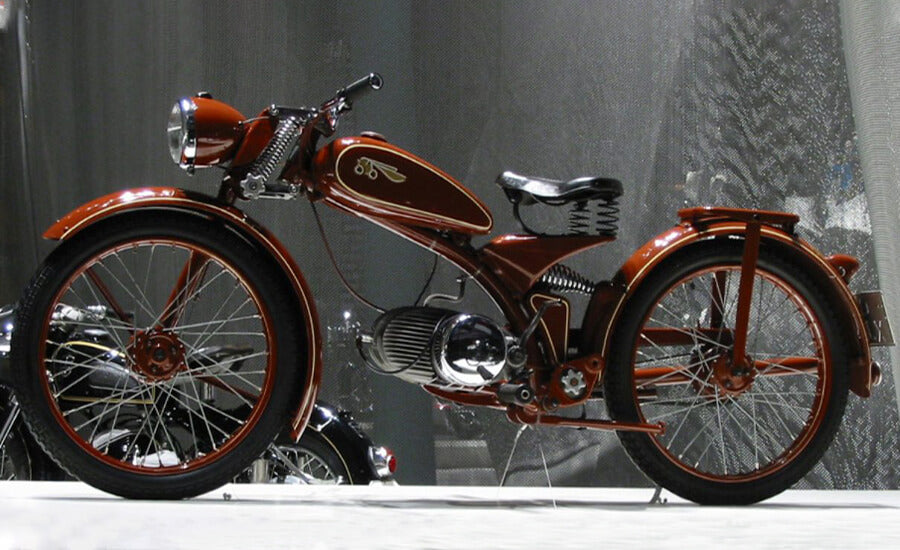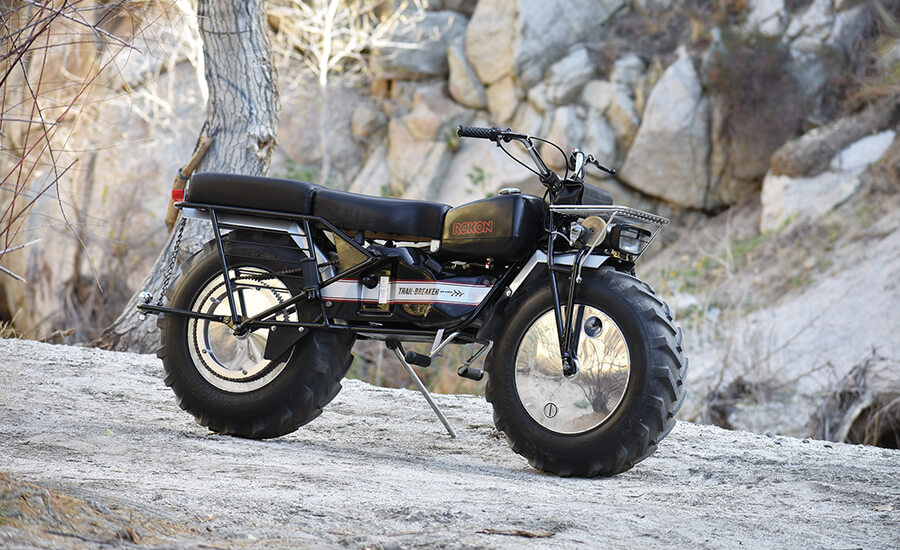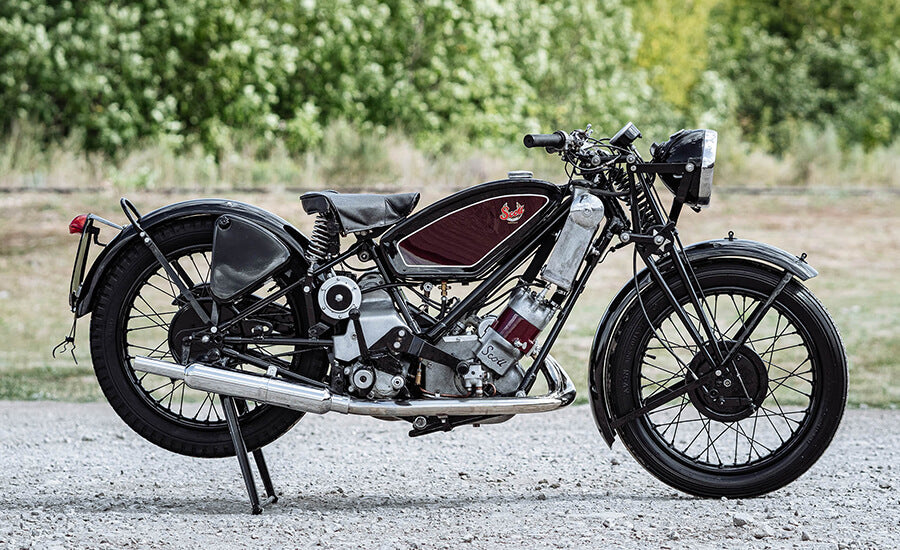Table of Content
There are countless motorcycle designs produced by different companies worldwide. This article discusses the top 10 weirdest motorcycle designs based on their seating position, suspension, fuel tank, chassis, drive system, and other features that make them different from standard motorcycles.
1. Megola

Manufactured in Germany from 1921 to 1925, the Megola featured one of the most unusual engine designs. There was no need for a clutch or gearbox because its 640 cc, five-cylinder, side-valve, air-cooled, four-stroke engine was attached directly to the front wheel.
The engine had a single carburetor placed on the right side of the fork. To operate, fuel had to be poured into a smaller fuel tank above the carburetor on the front fork; the larger reserve tank was connected to the riveted and welded monocoque frame.
If this bike was resting on its stand or had one of its wheels resting on the ground, the rider could just jump-start it and take off. It had a dual rear braking system rather than being fitted with a front brake. Different versions either had a saddle-style or bucket seat and a front fork with leaf spring suspension. This motorcycle performed well in competitions due to its superb handling and a top speed of 85 mph.
2. Quasar

Quasar was designed by the late Malcolm Newell and remained in production from 1976 to 1994. When riding the Quasar, the rider sits inside a frame rather than sitting on top of an open seat. Taller riders may have difficulty fitting inside, though it is possible to carry a passenger if you do not mind a tight squeeze.
The bike has a laminated glass front windscreen with heating and windshield wipers similar to those installed on cars. However, the semi-enclosed "cockpit" leaves more blind spots, forcing the rider to turn his/her head more frequently to check for any vehicles coming from behind.
Behind the rider is about 60 liters of storage space. The Quasar has a fiberglass body with a roof, a 750 cc four-cylinder Reliant car engine, a four-speed gearbox, weather protection, and great aerodynamics.
3. Suzuki Falcorustyco

The Suzuki Falcorustyco debuted at the 1985 Tokyo Motor Show. Its amazing technical innovations that captured the world's imagination have remained underrated 37 years later.
Just as the Suzuki Falcorustyco’s name is difficult to pronounce, it has an equally complex design. Its unique and futuristic design was too early for its time. This Suzuki model is powered by a 500 cc square four-four stroke engine, with its layout supporting the front and back swing arms.
The Suzuki Falcorustyco had electronically controlled suspensions, hydraulic steering, and propulsion systems. Although it was expected that this motorcycle would be mass-produced, the future is now uncertain.
4. Uno Dicycle

A Canadian youth named Ben Gulak visited China in 2006 and was shocked to see how many smaller vehicles were contributing significantly to city pollution. His solution for an environmentally friendly mode of transportation was a two-wheeled electric motorbike, the Uno Dicycle.
By adjusting one’s weight relative to the center of gravity, the rider could control the Uno Dicycle's forward motion. The bike speeds up when the rider leans forward and slows down when the rider leans back. The rider shifts from side to side to control steering. When the vehicle detects any shifts in weight, one of the two wheels is raised to help the vehicle tilt in the direction of the intended turn.
Gulak fractured his kneecap during the first test ride and further testing resulted in electrical fires. Eventually, a Californian robotics engineer joined Gulak's team; the Uno Dicycle was recognized as one of the top 10 inventions of 2008 by Popular Science Magazine.
5. Imme

Built from 1948 to 1951, the Imme was the best example of German engineering and efficiency ever. The Imme was a lightweight vehicle well ahead of its time with its single-sided front fork, single-sided rear swingarm, and cantilever rear suspension. The single-side swingarm also functioned as the exhaust system since this motorbike's engine, drivetrain, and rear end were all built as a single component. The early prototypes were powered by a tiny 98 cc two-stroke motor, while the later models were installed with a twin 148 cc engine. Imme's cutting-edge specifications also contributed to its popularity.
The Imme is on display at Barber Vintage Motorsports Museum, being one of the motorbikes included in "The Art of the Motorcycle" show at the Solomon R. Guggenheim Museum in 1998.
6. Rokon

Over the last century, several motorcycle designers considered including front and rear-wheel drives on their motorbikes. However, the only successful example of this design is the Rokon.
Charles Fehn created the Rokon in 1958, then Nethercutt Industries purchased the production rights in 1960. Production was transferred from California to Vermont to New Hampshire in the 1960s. In 1973, the Rokon was fitted with an automatic gearbox.
The Rokon has aggressive 12-inch wide tires, an overall length of 79 inches, and a 51-inch wheelbase. This motorcycle is capable of treading through water at least two feet deep. The motorbike can float due to its hollow drum wheels and tires allowing you to cross deep bodies of water.
7. Scott

The Scott was the first production motorcycle to be fitted with a foot gear shift and a kickstarter. The Scott originally had rotary disc intake valves in 1911. Scott's two-stroke design was ahead of its time, as other manufacturers would not use this design until the 1970s.
Although two-stroke engines were widely used in early motorcycle designs, they were far from ideal; they were noisy, smelly, unreliable, and prone to overheating. An Englishman named Alfred Scott transformed the two-stroke engine from a cheap, underpowered utility motor to a reliable, high-performance component. Scott’s two-stroke engine was a 333 cc liquid-cooled 180° crankshaft, parallel twin-cylinder engine.
8. Peraves MonoTracer MTE-150

The Peraves MonoTracer MTE-150 is an enclosed battery-powered enclosed cabin motorcycle fitted with a 1,200-lbs battery. The MonoTracer could generate a horsepower of 200 hp, had a peak speed of 150 mph, and could shift from 0-60 mph in under 4 seconds.
However, during its early years in production, the MonoTracer encountered problems when trying to branch out internationally. In 2013, the Environmental Protection Agency, U.S. Customs, and the Transportation Department refused to let the Switzerland-made electric vehicle enter the country during the first attempt.
9. Roadog

The American William "Wild Bill" Gelbke worked on surface-to-air weapon guidance systems for many military contractors in the 1960s. But when Gelbke was denied access to missile schematics, it was his breaking point, and he left to start a motorbike company. In 1966, Gelbke built the Roadog to be able to travel at a consistent speed of 100 mph.
The Roadog has a length of 17 feet and weighs 3,300 lbs. It was fitted with a 152 cu in, four-cylinder Chevy II engine, a Powerglide transmission connected to a modified Chevy differential, and Corvette disc brakes. Gelbke traveled over 20,000 miles during the Roadog’s first year on the road.
Due to its weight, the Roadog’s long frame does not have a kickstand and is constructed from chrome moly steel tubing. Instead, it is supported by four hydraulic jacks. After traveling the country, Gelbke developed the Auto-Four variant based on the Roadog. This variant utilized an Austin Mini engine and gearbox, but only eight models were ever manufactured and sold.
10. Ner-a-Car

The Ner-a-Car was produced in the United States and the United Kingdom from 1921 to 1926. It was another vehicle that could be customized with a bucket seat, had a low center of gravity, and had hub center steering. Ner-A-Car Corporation manufactured almost 10,000 Ner-a-Car models from 1921 to 1926.
The Ner-a-Car was first built with a five-speed friction drive fitted onto the rear wheel; the later version featured a three-speed transmission and chain drive system. In the United States, it was constructed with a 283 cc two-stroke single-cylinder engine. In the United Kingdom, it was fitted with a 347 cc four-stroke single-cylinder engine.
The left handlebar grip can be twisted to activate the clutch. The chassis is made of twin-channel steel, is constructed with a low stance, and offers amazing stability and handling. The Ner-a-Car includes a forward riding position, enclosed body, hub-center steering, low-slung perimeter chassis, and friction drive transmission.













Leave a comment
All comments are moderated before being published.
This site is protected by hCaptcha and the hCaptcha Privacy Policy and Terms of Service apply.